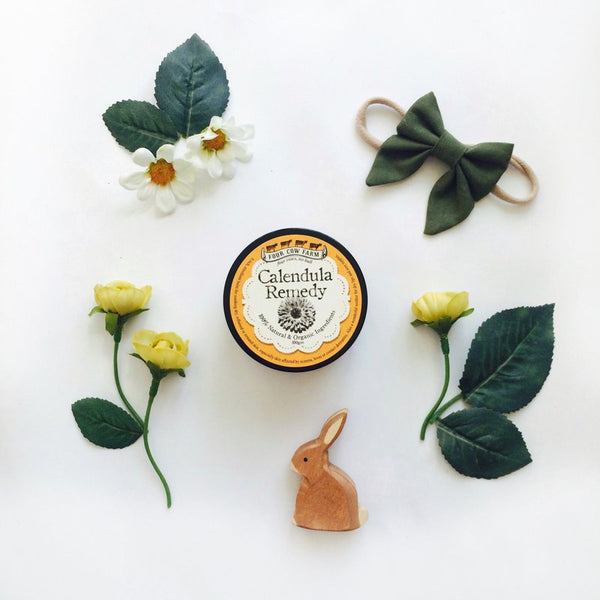
The itching, the rashes, the redness, the scratching. Every parent who’s had to deal with a little one with eczema knows those symptoms all too well. The cycle can be stressful and upsetting for both parent and tot. Here’s Four Cow Farm’s five-step guide to understanding and living with eczema.
Step 1 : Understand what’s happening under the skin of a little one with eczema
The word ‘eczema’ actually covers a very wide range of symptoms and conditions and many types of eczema exist. So, the best first step to take is to try and identify the type of eczema your little one has.
There are two broad groups of eczema - eczema which is triggered by direct skin contact with an irritant; and eczema which is caused by an increased sensitivity in the way your child’s immune system reacts with their environment. The latter is known as atopic eczema and is the fastest growing type of eczema.
A genetic twist of fate means that those with atopic eczema have skin that is unable to retain its own moisture (making it particularly prone to extreme dryness and itch) as well as particularly over-active immune systems that react to a variety of external influences (including the bacteria and yeast which live on all our kins!).
Step 2 : Discover the key triggers (not as easy as you might think!)
The next step is to begin whittling down the potential triggers of the symptoms - and there may be a few! An easy place to start is with the 3 ‘E’s of eczema :
(a) Edible – the most common trigger foods are cow’s milk, eggs, soya, wheat, fish and nuts.
(b) Environmental – the most common culprits are clothing, harsh soaps and detergents, perfumes and preservatives in skincare products, fabric softeners, extreme temperatures, humidity, dust mites, pollen and pets.
(c) Emotional – strong emotions such as stress and anger may trigger a worsening of the symptoms, as well as illness.
One of the best ways of identifying triggers is to remove them, one at a time, to see if your little one’s eczema improves. 4-6 weeks per trigger is best for certainty so patience, patience, patience…
Another approach is allergy testing which can be helpful if a specific allergy is suspected, though those with atopic eczema may test positive for none or many of the allergens tested. And all this will do will be to merely confirm that the form of eczema is atopic eczema (which, as described above, has its basis in the immune system), and not other forms of eczema whose main triggers are external.
Where the primary cause of eczema is an external irritant, identifying the culprit or culprits will see an immediate and marked improvement in your little one’s skin, or the disappearance of eczema entirely.
With atopic eczema, removing those key triggers will reduce the number of ‘flare-ups’ which take place, but the dryness and itchiness is likely to continue for a while, and helping your little one’s skin to cope with both on an ongoing basis will be absolutely crucial (we’ll tackle this in the next section).
Step 3 : Put in place a disciplined skincare regime (and we mean really disciplined!)
With atopic eczema, the skin is unable to hold onto its own moisture. This consistent dryness is a primary trigger of itching, which can often lead to flare-ups, so helping the skin retain its own moisture is absolutely key. One crucial period at which to protect the skin from loss of moisture is bath-time.
So be extremely careful and selective with shampoos, soaps and washes. Avoid products containing harsh synthetic detergents (such as sodium lauryl/laureth sulphate or cocamidopropyl betaine) and harsh preservatives (such as phenoxyethanol or benzyl alcohol).
Replenishing the skin’s moisture is key. And dermatologists all agree that regular, repeated moisturising is crucial to managing eczema. By helping the skin maintain its moisture, we help maintain the health of the skin, and its ability to defend itself against external triggers and allergens. So if there’s one mantra every parent needs to repeat when dealing with eczema, it’s ‘moisturise, moisturise, moisturise!’.
Parents and carers should, therefore, help the child to moisturise at regular intervals during the day, And as you’ll be applying your chosen moisturiser very, very often, make sure it’s made from the very best natural ingredients. Skin with eczema is often thinner and more likely to absorb and react to the substances placed on it, so avoid anything containing synthetic nasties, artificial chemicals, added fragrances or petroleum derivatives (see the Four Cow Farm Guide on Baby Skincare for more on selecting safe skincare).
Step 4 : Get your little one involved
The good news in all of this? Many children often see the symptoms lessen with age although many will continue to have sensitive skin. So what better time than now to begin teaching him or her to start looking after their own skin? Involve them in applying moisturisers or creams, allow them to be part of making up the bath and using the (gentle) soap or bath oil you’ve chosen. And teach your little one to manage the itchiness that comes with eczema. Whether it’s a cool compress, or putting on a soothing lotion, or tickling or patting as alternatives to scratching, there are a myriad of techniques that will help those little fingers find gentler ways of soothing their skin.
Being the parent of a child with eczema can be a frustrating, nerve-wracking and exhausting ride. And perhaps one thing to remember is that being a child with atopic eczema has its ups and its downs, its good days and its bad, and that’s all part of the whole experience. Sometimes, the real challenge of eczema is earning to manage you and your little one’s journey through it with a few tips, some discipline and a lot of love and patience!
For more information, you may continue How to Care for Skin with Eczema.
